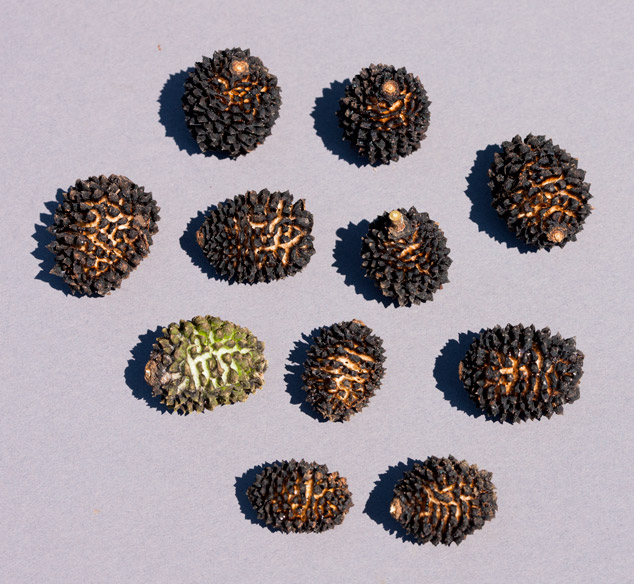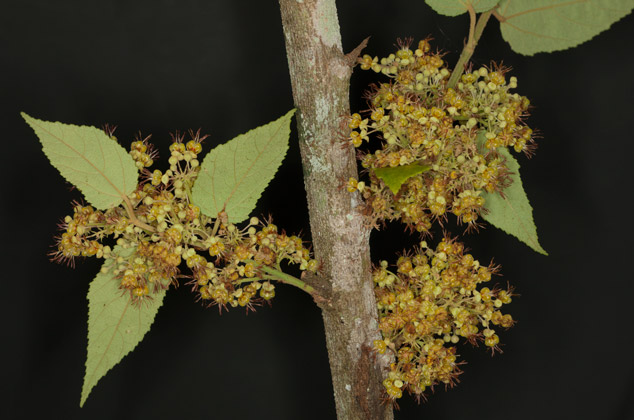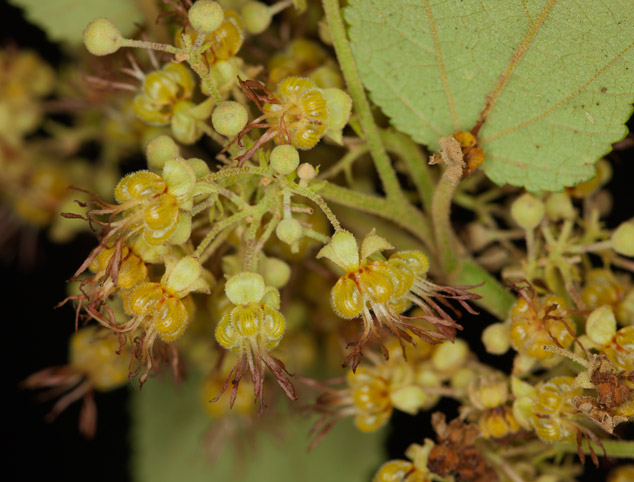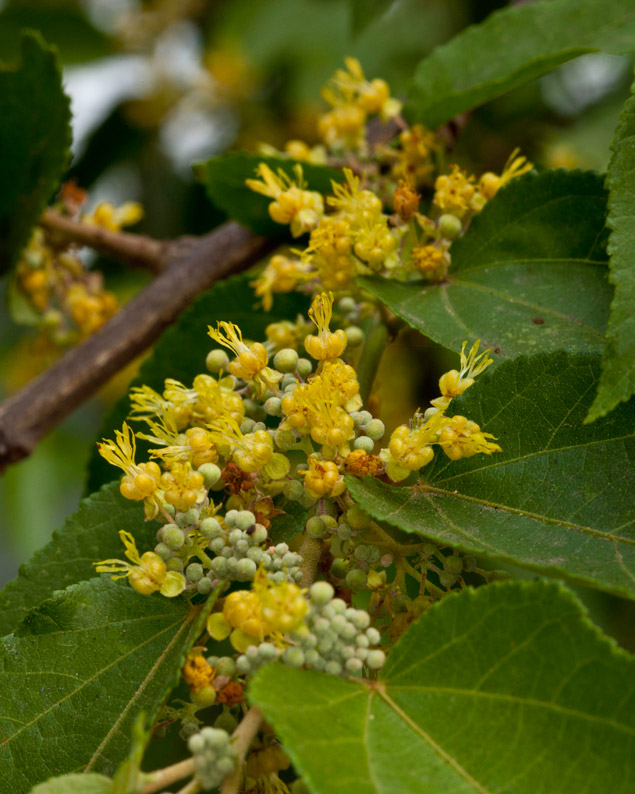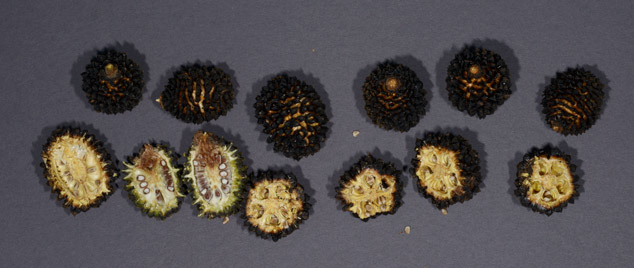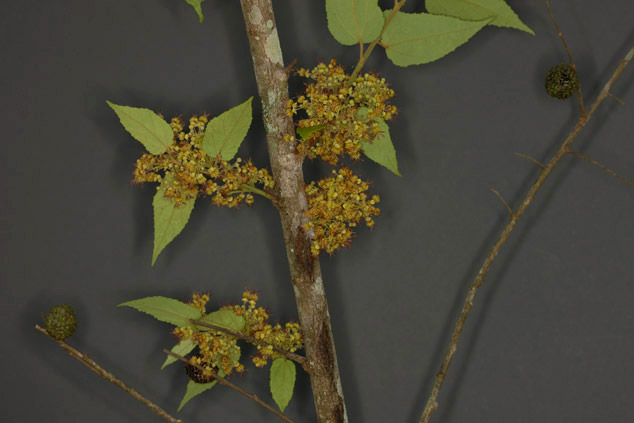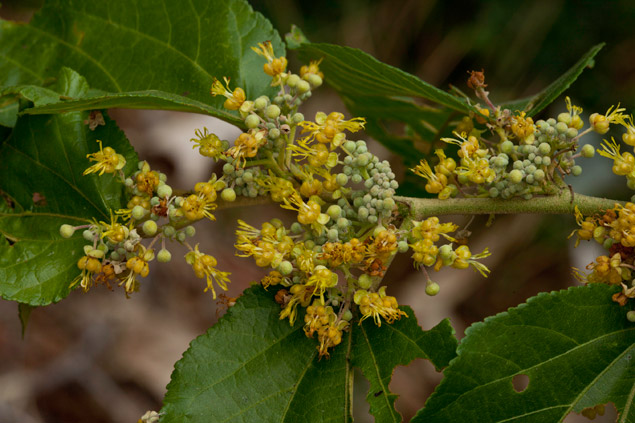Local names for Guazuma ulmifolia
Common names include guácima, guácimo (Spanish); tablote, majagua de toro (Mexico); tapaculo (Guatemala, El Salvador); cualote (Guatemala, Honduras, El Salvador, Colombia); contamal (Guatemala); chicharrón (El Salvador); bay cedar, caulote, pixoy (Belize)
(www.winrock.org/fnrm/factnet/factpub/factsh/gulmifol.htm).
The names I heard in Guatemala were cualote (or cualote) and tapaculo.
Several articles on Maya home gardens list Guazuma ulmifolia
Vogl et al. 2002: Table 2
Azurdia et al. no date, page 8
Appendix VI: Most frequent home garden plants Heindorf 2011:143
Fiber from Guazuma ulmifolia
Cyrus Lundell lists two uses for Guazuma, shade and fiber. He also lists shade as the use he knows of for Cassia grandis, bukut (bucute), which is another flavoring for cacao a thousand years ago.
As a fixative for reconstructing murals
Ma. Cristina Ruiz has produced an entire article on Pixoy (Guazuma ulmifolia) as a fixative for murals (on lime plastered walls of Maya buildings).
The tree product can also be mixed with lime to help make house floors among Itza of Peten (Atran 48).
Edible fruit (or nut, depending on your point of view)
The nut is about the size of a large olive. It is dingy black color; looks and feels hard and dry on the outside, and is about a friendly looking as it's almost prickly like surface
But these are not spines or thorns; they do not stick in your fingers. I handled a lot of them, picking them off the tree or off the ground. None stuck my flesh.
Every single local person, in all parts of the country, said they readily ate these when they were children. But not many adults would try them.
I frankly found it a challenge to see what about it was edible, but everyone praised the taste. Probably I was looking at ones which were too green or too old and dry (so premature or ones which were too old).
But I was not able to find a universal common term for this plant (at least not one that stuck in my memory).
Drink and Cacao Flavoring (indigenous Mayan chocolate drinks)
Usos culinarios: El fruto es dulce y se come crudo (molido o seco) o cocido en áreas rurales de todo Panamá. Los indígenas de la provincia de Darién absorben la pulpa de los frutos crudos. El fruto maduro es duro, leñoso y tiene un sabor dulce y un aroma especiado agradable. Se dice que las flores también son comestibles. Los frutos y las semillas molidas se usan en algunos lugares para elaborar bebidas refrescantes, así como siropes De los frutos maduros también se elabora un tipo de refresco, que se prepara macerando los frutos maduros con agua y azúcar y se revuelve muy bien hasta que adquiere un sabor agradable. La semilla molida se usa para saborizar el chocolate y también se consume tostada como el café. En México se preparan tortillas, atole y pinole con las semillas y frutos maduros. El cocimiento de la corteza, el jugo o los frutos macerados en agua se utiliza para aclarar jarabes en la manufactura del azúcar de caña y para limpiar el guarapo de la caña cuando se hace la melaza.
…. Se ha registrado que las hojas de guácimo contienen cafeína. Chizmar 2009308-309).
Akit (-tik) is the comomon lowland tree Guazuma ulmifolia (5-9). This fuzzy-leaved low tree has small, oblong, hard, spiny fruits up to 3 cm long, with a distinct chocolate odor (Breedlove and Laughlin 1993:152).
Guazuma as a medicine for the Maya
Listed as a medicine for the Lacandon (Levy et al 2006:94). Alonso-Castro and Salazar-Oilvo list anti-diabetic properties (2008). Chizmar (below) lists even more medicinal uses.
Al guácimo se le han adjudicado múltiples usos medicinales y es uno de los remedios más populares contra los padecimientos gastrointestinales. La corteza, hojas, flores y frutos tienen uso medicinal contra fiebre, vómito, diarrea, dolor de matriz, gastritis, diabetes, para curar llagas, retención de orina, sífilis, tos, paludismo, inapetencia, antiespasmódico, afecciones pectorales, catarro, antipirético, dolor de abdomen, antibiótico, antidiabético, antiinflamatorio, antiséptico, astringente, caída del cabello, purgante y para combatir las afecciones epiteliales. Las raíces y los frutos molidos son emolientes y antivenéreos; el mucílago tratado con agua hirviendo se aplica para insolación y quemaduras. La corteza se utiliza en cocción como diurético, en agua fría contra la diarrea, diarrea con sangre, pujo y afecciones renales. En Belice, la corteza hervida por 10 minutos se bebe para la disentería y la diarrea, ayuda en los problemas de próstata y se usa como estimulante uterino para acelerar el parto. (Chizmar 2009 309-310).
The bark is one part used for medicine.
Where to find Guazuma ulmifolia?
We found it along the highway parallel to Rio de los Esclavos, a very dry area one hour from Guatemala City.
Listed for Polochic wetlands, as common (Information Sheet on Ramsar Wetlands, page 5).
Listed for Xyshal, Guatemala (http://indigenousknowledgeproject.org/plants/the-americas/central-america/guatemala/caulote-"guazuma-ulmifolia").
Listed for Candelaria cave area of Alta Verapaz. Actually we found this tree throughout Peten, Izabal, and even in the Motagua desert area (which is even dryer than the Rio de los Esclavos area). Yet Guazuma ulmifolia is common at Tikal. In fact in the Parque Nacional Tikal (El Peten) we found Guazuma ulmifolia flowering.
There is a town named Cualotes, in Guatemala, next to the border with Honduras, near Copan Ruinas (though not on the main highway).
The tree is also present in Yucatan, Belize, Copan Ruinas Honduras, and I would thus expect it throughout many eco-systems of Mesoamerica. The Polochic wetlands and the Rio de los Esclavos area are about as different in rainfall and elevation as I can imagine.
When does Guazuma ulmifolia flower?
Flowers in Costa Rica January through March and then in July (http://curis.ku.dk/portal-life/files/20647544/guazuma_ulmifolia_int.pdf)
The species itself flowers throughout the year, in particular from April to October. (Wikipedia).
In large March we found old dry fruits on hundreds of trees in diverse eco-systems. In Peten and nearby we also found lots of green (unripe) fruits. We found flowers only on one single tree: at Tikal. Elsewhere at Tikal the fruit was already present, either green or dry. Some were in edible stage: dark, but before they dry out to nothingness.
Summary on Guazuma ulmifolia as cacao flavoring (for chocolate)
I had never heard of this tree before I started to study flavoring for cacao. And after spending several hours for several days researching this tree I was surprised to learn how many uses there were for such a frankly miserable looking stubby hard woody "fruit" and a rather wimpy scraggly tree. Once I recognized what the tree looked like, I realized that it grew throughout many areas of Guatemala: both dry and wet.
Its medicinal uses are longer than I can keep mental track of (probably I need to take some Guazuma ulmifolia to improve my mental abilities).
It's practical uses are also many: fiber, fruit, construction, firewood, and charcoal to make soap! Archaeologists today use it to treat murals and stucco (and some Maya already used it to add to lime for making their floors).
Most students will probably want to do their thesis on a more photogenic and exciting-looking tree and fruit, but there sure is plenty of material here for a thesis.
Photographs of Guazuma ulmifolia
The knobby fruit is vaguely photogenic, if the lighting is at an appropriate angle to bring out the surface features.
Bibliography for Guazuma ulmifolia, related to cacao and chocolate
- 2008
- The anti-diabetic properties of Guazuma ulmifolia Lam. are mediated by the stimulation of glucose uptake in normal and diabetic adipocytes without inducing adipogenesis. J. Ethnopharmacol. 118:252-256
- 2004
- Plants of the Petén Itza' Maya. Museum of Anthropology, University of Michigan Memoirs, Number 38. 248 pages.
- 2009
- Plantas comestibles de Centroamerica. Instituto Nacional de Biodiversidad, INBio, Costa Rica. 360 pages.
- Guazuma ulmifolia
- 2011
- Analysis of the Agrobiodiversity of Home Gardens in the tropical Regions of Mexico. Thesis. Universidad Autonoma de San Luis Potosi and Cologne University of Applied Sciences.
- 2006
- Aspectos floristicos de Lacanja Chansayab, Selva Lacandona, Chiapas. Acta Botanica Mexicana, Octobre, numero 077, pp. 69-98. Instituto de Ecologia A.C., Patzcuaro, Mexico.
- 1938
- Plants probably utilized by the Old Empire Maya of Peten and adjacent Lowlands." Papers of the Michigan Academy of Sciences, Arts, and Letters; vol. 24, pp: 37-56. Ann Arbor: University of Michigan.
- 2007
- Hypotensive and Vasorelaxant effects of theprocyanidin fraction from Guazuma ulmifolia bark in normotensive and hypertensive rats. Journal of Ethnopharmacolory, 117: 58-68.
- 2009
- El Pixoy como material de conservacion de pintura mural y relieves policromos en el area Maya. Centro INAH, Yucatan.
- 2002
- Homegardens of Maya Migrants in the District of Palenque (Chiapas/Mexico): Implications for Sustainable Rural Development. In: Stepp, J.R., Wyndham, F.S., and R.K. Zarger (eds.). Ethnobiology and Biocultural Diversity. p 631 – 647. University of Georgia Press, Athens, Georgia.
- 2002
- Children's ethnoecological Knowledge: Situated Learning and the Cultural Transmission of Subsisence Knowledge and Skills among Q'eqche' Maya. PhD dissertation, University of Georgia, Athens, Georgia.
www.fs.fed.us/global/iitf/Guazumaulmifolia.pdf
http://curis.ku.dk/portal-life/files/20647544/guazuma_ulmifolia_int.pdf
First posted April 1, 2013.


